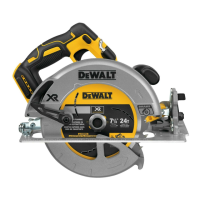16
ENGLISH
the cut. Forcing a correction inside the cut can stall the saw and
lead tokickback.
IF SAW STALLS, RELEASE THE TRIGGER AND BACK THE SAW
UNTIL IT IS LOOSE. BE SURE BLADE IS STRAIGHT IN THE CUT AND
CLEAR OF THE CUTTING EDGE BEFORERESTARTING.
As you finish a cut, release the trigger and allow the blade to
stop before lifting the saw from the work. As you lift the saw,
the spring-tensioned telescoping guard will automatically close
under the blade. Remember the blade is exposed until this
occurs. Never reach under the work for any reason. When you
have to retract the telescoping guard manually (as is necessary
for starting pocket cuts) always use the retractinglever.
NOTE: When cutting thin strips, be careful to ensure that small
cutoff pieces don’t hang up on inside of lowerguard.
Pocket Cutting (Fig.O)
WARNING: Never tie the blade guard in a raised position.
Never move the saw backwards when pocket cutting. This
may cause the unit to raise up off the work surface which
could causeinjury.
A pocket cut is one that is made in a floor, wall or other
flatsurface.
1. Adjust the saw base plate so the blade cuts at desireddepth.
2. Tilt the saw forward and rest front of the base plate on
material to becut.
3. Using the lower guard lever, retract lower blade guard to an
upward position. Lower rear of base plate until blade teeth
almost touch cuttingline.
4. Release the blade guard (its contact with the work will keep
it in position to open freely as you start the cut). Remove
hand from guard lever and firmly grip auxiliary handle
12
,
as shown in FigureO. Position your body and arm to allow
you to resist kickback if itoccurs.
5. Make sure blade is not in contact with cutting surface before
startingsaw.
6. Start the motor and gradually lower the saw until its base
plate rests flat on the material to be cut. Advance saw along
the cutting line until cut iscompleted.
7. Release trigger and allow blade to stop completely before
withdrawing the blade from thematerial.
8. When starting each new cut, repeat asabove.
Dust Extraction (Fig.Q)
WARNING: Risk of dust inhalation. To reduce the risk of
personal injury, ALWAYS wear an approved dustmask.
A dust extraction port
30
is supplied with yourtool.
The Dust Extraction Adaptor
31
allows you to connect the tool
to an external dust extractor, either using the AirLock™ system
(DWV9000-XJ), or a standard 35mm dust extractorfitment.
WARNING: ALWAYS use a vacuum extractor designed
in compliance with the applicable directives regarding
dust emission when sawing wood. Vacuum hoses of most
common vacuum cleaners will fit directly into the dust
extractionoutlet.
MAINTENANCE
Your DeWALT power tool has been designed to operate
over a long period of time with a minimum of maintenance.
Continuous satisfactory operation depends upon proper tool
care and regularcleaning.
WARNING: To reduce the risk of serious personal
injury, turn tool off and disconnect battery pack
before making any adjustments or removing/
installing attachments or accessories. An accidental
start-up can causeinjury.
The charger and battery pack are notserviceable.
Lubrication
Self lubricating ball and roller bearings are used in the tool and
relubrication is not required. However, it is recommended that,
once a year, you take or send the tool to a service center for a
thorough cleaning, inspection and lubrication of the gearcase.
Cleaning
WARNING: Blow dirt and dust out of the main housing
with dry air as often as dirt is seen collecting in and around
the air vents. Wear approved eye protection and approved
dust mask when performing thisprocedure.
WARNING: Never use solvents or other harsh chemicals
for cleaning the non-metallic parts of the tool. These
chemicals may weaken the materials used in these parts.
Use a cloth dampened only with water and mild soap.
Never let any liquid get inside the tool; never immerse any
part of the tool into aliquid.
Lower Guard
The lower guard should always rotate and close freely from
a fully open to fully closed position. Always check for correct
operation before cutting by fully opening the guard and letting
it close. If the guard closes slowly or not completely, it will
need cleaning or servicing. Do not use the saw until it functions
correctly. To clean the guard, use dry air or a soft brush to
remove all accumulated sawdust or debris from the path of
the guard and from around the guard spring. Should this not
correct the problem, it will need to be serviced by an authorized
servicecenter.
Base Plate Adjustment (Fig.G, H)
Your base plate has been factory set to assure that the blade is
perpendicular to the base plate. If after extended use you need
to re-align the blade, follow the directions below:
Adjusting for 90 Degree Cuts
1. Return the saw to 0degreesbevel.

